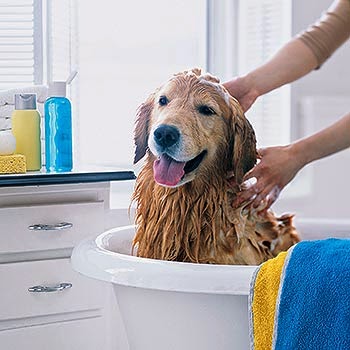The effectiveness of the following solutions to different substance will depend on the kind of hair your dog has. Harsher coats usually will be easier to clean up because the hair is stronger and typically its structure will naturally repel a lot of the most common substances, keeping them on the surface.
On double coated dogs, any substance that gets in contact will penetrate the soft undercoat, making it a little more difficult to remove the substance and often calling for a second round of the designated cleaning process. Here are some of the most common problems.
Grease
You must act as fast as you can to remove grease because it could spread all over the dog pretty quickly, and if your dog decides to groom himself, licking the substances could be toxic.
First, apply a generous amount of cornstarch and massage the stain to make sure that most of the grease gets absorbed. After a couple of minutes, brush the powder off, preferably with an old slicker brush or one that you can wash. You don’t want to have the brush you regularly use impregnated with grease. Proceed to wash his paws or the affected areas with a degreasing shampoo or a small amount of dish washing liquid.
Let the shampoo sit for a couple of minutes and then rinse off thoroughly. Repeat if necessary. Using a washcloth could also
help remove the oil. Dry the affected area and then apply a small amount of cornstarch or baby powder to be sure that any oily residue gets absorbed.
Dirt and Mud
If your dog had too much fun running through puddles of mud and you don’t have a tub handy to give him a bath, the best solution is to let him dry and then, after sprinkling some Cornstarch over the dirty areas, brush off the mud with the help of a slicker brush.
Gum
Not only is it horrifying to find a piece of gum in our dog’s hair, but to think where it was before is even more horrifying. Thankfully, removing the gum is not as hard as it seems.
One easy solution is to impregnate the gum with peanut butter. Work it in well with your fingers to allow the oil to break apart the gum. After a couple of minutes, use a comb to start opening the gum from the outside first while still working in more of the peanut butter.
Don’t worry about sticky fingers—I’m sure your dog will be happy to help
with that. Keeping your dog’s paws well trimmed is the best way to prevent gum from sticking to your dog’s pads.
Paint
Water-based paints are not hard to remove. If it has already dried, use a slicker brush to get rid of as much paint as possible to break the “seal.” Follow by soaking a washcloth with shampoo (if it doesn’t
work, use some dish detergent). Follow by rinsing the area well.
Oil paint can be a bit more difficult to remove. Soak the stain with vegetable oil, let it sit overnight, and then proceed to remove the paint with a wash‑cloth soaked in dish detergent. Rinse well. If the painted spot is on an area where the dog can lickit, cover it with a t-shirt or a bandage. Sometimes, depending on the temperament of your dog, it is a good idea to use an E-collar to prevent him from reaching the affected area.
Candle Wax
The first step should be to check to make sure that the hot wax hasn’t reached and burned the skin.
Start by removing as much of the wax as you can with the end of a comb and working it with your fingers to crack it as much as possible. Add some peanut butter, vegetable oil, or mineral oil on the affected area and after working it with your fingers, use the comb to help the wax slip off. Never apply heat to melt the wax because it could easily burn the dog. Wash the area and rinse well.
Superglue
As implied by the name, superglue is not easy to remove. Like gum, trying to loosen it with vegetable or mineral oil could work. Let it sit for a few minutes and then use a comb to try to remove it, working on a small portion at a time.
If this doesn’t work and the glue mess is superficial enough, carefully trimming the hair could be the only option. Carefully slide a comb under the glue and without pulling, so as not to hurt the dog, with a small pair of round-tip scissors, cut the portion of hair affected halfway. With your fingers, open up the hair and repeat the oil process. Use a washcloth soaked in dish washing liquid and work it with your fingers. Rinse well.
Skunk Smell
There are 1,001 opinions on how best to remove skunk smell from your dog. First, it is important to understand exactly what this agent is and what it is made of. The substance that a skunk sprays is an oily secretion, generated from glands under the skunk’s tail, whose basic chemical compound is called thiol.
Thiol is a resistant substance that bonds with proteins, which is why it will remain even after washing. Similar compounds are found in onions and in garlic, which is why their smell also lingers after washing our hands. Tomato juice will only mask the smell. To neutralize the skunk’s secretions, use a mixture of 1 quart (945 ml) 3 percent hydrogen peroxide and 1/4 cup (55 g) baking soda. Add a little liquid detergent to this mix.
Remember that the skunk will most likely spray your dog when he is approaching him, so the biggest concentration will be on your dog’s face. Using a washcloth soaked in the peroxide solution will allow you to get to every little corner of your dog’s face.

